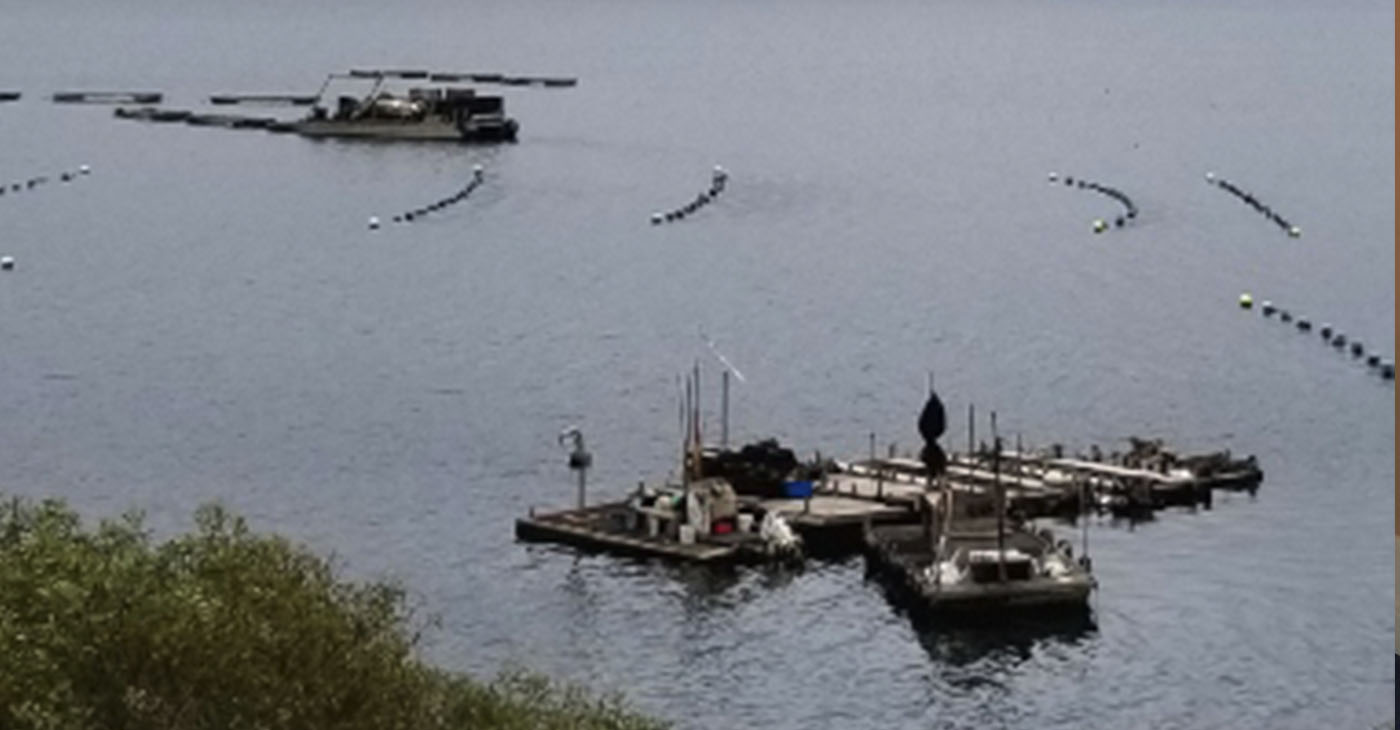Bay Area
Value of Marin Agricultural Products Slips 5%
As in past drought years, the resiliency of local farmers, ranchers, and their workforce was noted in the annual report. The lingering COVID-19 pandemic required agricultural producers to find new markets to sell their products to stay viable and handling complicated issues with human resources around their facilities.

On the positive side, West Marin aquaculture experiences a comeback
Courtesy of Marin County
Agricultural production in Marin County shrunk by 5% in 2021 compared with the previous year, mostly because of the ongoing drought and farmers opting to fallow more of their land.
Assistant Agricultural Commissioner Scott Wise and Inspector Allison Klein presented the 2021 Marin County Crop & Livestock Report to the Marin County Board of Supervisors on June 14. The estimated gross total production value of local products was $96,656,000, down from $101,840,000 in 2020 and wiping out a 4% gain in value between 2019 and 2020. Only three times in history has Marin eclipsed the $100 million mark in annual gross value of agricultural products. The record is $111,061,000 in 2015.
As in past drought years, the resiliency of local farmers, ranchers, and their workforce was noted in the annual report. The lingering COVID-19 pandemic required agricultural producers to find new markets to sell their products to stay viable and handling complicated issues with human resources around their facilities.
“We are now seeing the data that shows the long-term impacts this drought is having on our agricultural industry, such as significant reductions in livestock, exorbitant feed costs, and fallowing of land,” Wise told the Board members. “In 2021, Marin’s share of this megadrought reached critical levels. Due to the lack of precipitation, ponds and wells ran dry and many farmers and ranchers resorted to hauling water to their ag operations. Still, there is only so much water an operation can afford to haul, so many growers had to fallow fields and many ranchers were forced to sell off animals.”
Marin experienced record low rainfall and a second consecutive dry winter, affecting everything from livestock to field crops to fruits and vegetables. It takes years to rebuild a livestock herd for specific traits and genetics, and crop and livestock producers are working hard to build drought resiliency into their operations.
The brightest news in the report came in the area of aquaculture, an important part of the West Marin economy. The total gross value of oysters, mussels, and clams jumped from $3.75 million to $8.2 million, an increase of 119%. The increase was attributed to revitalized demand by consumers after a year of coronavirus lockdowns and restaurant closures in 2020.
On the downside, field crops continued to slip in value because of the drought. The value of hay was down 49%, silage down 43% and harvested pasture down 33% (much of hay and silage are not sold but instead stay on local farms as feed). The total value of field crops fell from $14 million to just over $9 million. Also, fruits & vegetables were down 34% and nursery products went down 25%.
Livestock products led the way by accounting for 41% over the overall gross value of Marin agricultural products. However, the value of cattle was down 13%, slipping from just over $16 million to just under $14 million. Conventional milk production value was up 7% but the organic milk sector – traditionally a strong point for Marin farmers – was down 8%.
Over the past year, 21 Marin ranchers participated in a livestock protection cost-share program to help build and repair fences, purchase and support protection animals, and use scare devices to protect animals from predators. Protected animals include sheep, poultry, goats, cattle, water buffalo, and alpacas.
The annual report includes updates on pest prevention programs, sudden oak death, invasive weed management, and the organic certification program. All Marin County livestock and crop reports are online, including the new one. Reports are sent to the California Department of Food and Agriculture to be included in statewide reports.
Activism
Oakland Post: Week of July 24 – 30, 2024
The printed Weekly Edition of the Oakland Post: Week of July 24 – 30, 2024

To enlarge your view of this issue, use the slider, magnifying glass icon or full page icon in the lower right corner of the browser window. ![]()
Activism
Oakland Post: Week of July 17 -23, 2024
The printed Weekly Edition of the Oakland Post: Week of July 17 -23, 2024

To enlarge your view of this issue, use the slider, magnifying glass icon or full page icon in the lower right corner of the browser window. ![]()
Bay Area
Op-Ed Senate Bill 966 Threatens Health Equity in East Bay
My East Bay community is struggling to get by. A proposed State Senate bill would set us back even further. Serving the East Bay community has been my life’s work and my greatest joy. After leaving the Bay Area to complete my seminary, I returned home to found The Community Church in Oakland. From the outset of my time as the church’s pastor, I have been guided by the belief that my service must extend beyond the pulpit, because the health and economic needs of my community are so great. Our church has organized free food banks, COVID-19 testing clinics, and a housing and re-entry program for those suffering from addiction.

By Rev. Dr. Lawrence E. VanHook
Special to the Post
My East Bay community is struggling to get by. A proposed State Senate bill would set us back even further.
Serving the East Bay community has been my life’s work and my greatest joy. After leaving the Bay Area to complete my seminary, I returned home to found The Community Church in Oakland.
From the outset of my time as the church’s pastor, I have been guided by the belief that my service must extend beyond the pulpit, because the health and economic needs of my community are so great. Our church has organized free food banks, COVID-19 testing clinics, and a housing and re-entry program for those suffering from addiction.
Through my service, I have seen the challenges that our community members are facing. Oakland, my hometown, has the third-highest rate of violent crime in the state. The local economy is strained. Oakland-based businesses are leaving our community because they’re struggling to get ahead.
Both East and West Oakland has disproportionately high rates of respiratory illness due to heavy air pollution. While our local efforts have brought some aid to those in need, we are also counting on our state elected officials to help us address the systemic health disparities afflicting the community.
Chief among the health concerns of community members is having reliable and affordable access to prescription drugs. Equitable access to medications gives us the peace of mind that we can keep ourselves and our families healthy and safe. Our community should not have to choose between paying rent or purchasing prescriptions.
Unfortunately, rather than taking action to combat soaring prescription drug prices, some California lawmakers are pushing legislation that could raise patient costs at the pharmacy counter.
The Legislature is currently considering SB 966, a bill backed by special interests that would undercut the few tools we have to keep prescription drug costs contained, letting big drug companies increase their prices, profiting on the backs of working families – some of whom already live paycheck to paycheck.
SB 966 would target the fundamental programs through which small businesses, unions, and government health programs are able to offer their employees and members quality and affordable healthcare. Millions of Californians rely on these plans to obtain essential medications at the lowest-possible cost.
The bill would make it illegal for employers and unions to incentivize the administrators of their prescription drug plans to negotiate for the lowest possible cost for prescriptions. Right now, small businesses and unions can choose to pay these administrators more for taking on big drug companies and securing discounts – a choice that will be outlawed under this bill.
As a result, employers will have no leverage to stop big drug companies from setting sky-high prices, disproportionately impacting working families.
As these health costs quickly add up, employers will have little choice but to pass the increases down to their employees. That means California patients will see higher healthcare costs and co-pays.
From my perspective, most concerning is that the bill would exacerbate the health disparities impacting my community and other underserved populations. If SB 966 becomes law, the most vulnerable may be forced to skip prescription doses, stop filling their prescriptions, and avoid essential care.
By rejecting this cash grab by big drug companies, our state elected officials can send a clear message that they stand with the community, patients, and working families.
We cannot afford SB 966.
Rev. Dr. VanHook is the founder and pastor of The Community Church in Oakland and the founder of The Charis House, a re-entry facility for men recovering from alcohol and drug abuse.
-

 Arts and Culture3 weeks ago
Arts and Culture3 weeks agoRooted in Tradition: The Intricate History of Black Hair Braiding
-

 Bay Area4 weeks ago
Bay Area4 weeks ago“I Will Not Be Bullied,” Says Oakland Mayor Sheng Thao
-

 Bay Area2 weeks ago
Bay Area2 weeks agoPG&E Increases Rates While Bay Area Households Are Struggling to Stay Afloat
-

 Business3 weeks ago
Business3 weeks agoGov Newsom: Raising Fast Food Minimum Wage to $20 Pays Off as Jobs Multiply in Industry
-

 Activism4 weeks ago
Activism4 weeks agoOpponents of Mayor Sheng Thao Are Calling on Her to Resign Following FBI Raid
-

 Community1 week ago
Community1 week agoHundreds Come to Jehovah’s Witnesses’ Assembly Hall for Three-Day Program of ‘Good News’ in Fremont
-

 Bay Area2 weeks ago
Bay Area2 weeks agoJuneteenth Mass Shooting Suspect Charge with Multiple Counts of Felony Assault by Alameda County DA Pamela Price
-

 Activism4 weeks ago
Activism4 weeks agoOakland Coliseum Sale to AASEG: A Model for Community Development and Inclusion























































